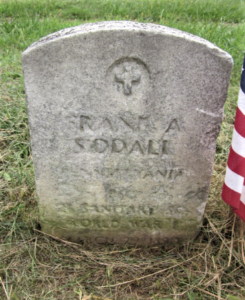Title: Army Private, First Class, World War I
Birthdate: March 29, 1890
Death Date: November 28, 1951
Plot Location: Section E

Having a bedroom to yourself was something most children couldn’t imagine if they grew up in a row house in the Point Breeze section of South Philadelphia. Frank and his six siblings certainly couldn’t, but that was how things were. At the dawn of the 20th century his father was a hostler, or stableman, tending to horses, but later worked at the Atlantic oil refinery by the Schuylkill River.
Frank went in the opposite direction when he was a young adult, to a jewelry store in Center City. His earliest known job was as a clerk at J.E. Caldwell & Company. It was a well-known retailer locally, but also gained national recognition for its silver services presented to battleships and cruisers of the US Navy. Except for his service in the Great War, Frank worked at the store at 1319 Chestnut Street his entire life. The company was sold to Carlyle & Company in 1992 and the store closed in 2003.
The Selective Service Act of 1917 required Frank to register for the draft, which he did in June of that year. He was inducted on April 27, 1918 and assigned to the US Army Ambulance Service (USAAS) whose mission was to evacuate casualties from the front. The most basic unit was the Sanitary Squad, consisting of 45 men, 20 Ford ambulances, a truck, and a kitchen trailer.
Training took place at the Allentown, Pennsylvania fair ground, which the Army rented and named it Camp Crane. Recruits learned first aid, evacuation drills, ambulance repair and maintenance, plus learning how to drive a motorized vehicle, since it was a relatively new skill. Frank’s camp training lasted less than a month. Whatever else he needed to know was taught while onboard the ship to France. He was in Sanitary Squad #21, Ambulance Section, 305th Sanitary Train, 80th Division.
He was promoted to Private First Class in December, 1918, then came home and was discharged in June of 1919. They welcomed him back at J.E. Caldwell and he became a salesman on the jewelry counter. He was also the only one of the children living at home with his parents in 1920, so he finally did have a bedroom to himself. It didn’t last long, however. A June wedding in 1921 united Frank with Jenny Bunting Whiteside. Their first child, Frank Sanborn Siddall, arrived on December 27, 1921.
The family joined the westward migration to the suburbs, living at 238 Kent Road in Upper Darby for the next 30 years. Frank held onto his job throughout the Depression, commuting every day to Center City, and becoming a buyer for the company. They welcomed a  daughter in 1938 and saw their son become a decorated Navy pilot in World War II, shown here.
daughter in 1938 and saw their son become a decorated Navy pilot in World War II, shown here.
In early 1951 Frank was diagnosed with Hodgkin Lymphoma, a cancer of the blood, and he died before year’s end. His military headstone marks his grave in Section E beside his brother William and his parents, George and Jennie. They both died in 1937. His grandparents, also named George and Jennie, were buried in Section 204.

Support the Friends of Mount Moriah
Help us in our mission to restore and maintain the beautiful Mount Moriah Cemetery by donating to our cause or volunteering at one of our clean-up events.

